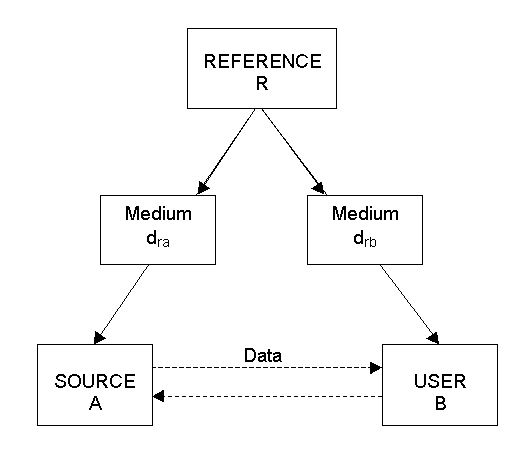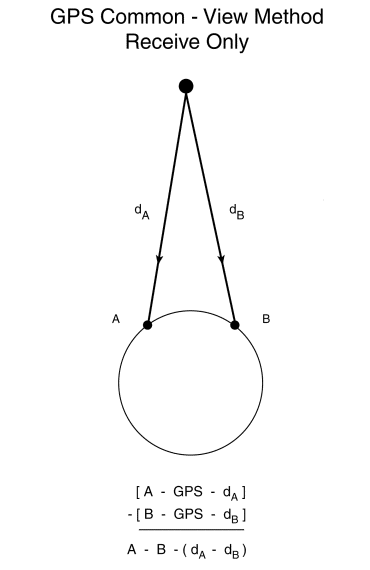

|
|
|
|
Common View GPS Time Transfer
|
|
|
|
|
An approach that builds and improves on the one-way technique is common-view time transfer. This technique allows the direct comparison of two clocks at remote locations. A generic common-view setup is illustrated in the figure. In this technique, two stations, A and B, receive a one-way signal simultaneously from a single transmitter and measure the time difference between this received signal and their own local clock. The data are then exchanged between stations A and B using any convenient method (email, FTP, etc.).
The time difference between clocks A and B is calculated by taking the difference between simultaneous R - A and R - B clock difference measurements. If the travel times to the receivers are exactly equal, then the two receivers can synchronize their clocks with an accuracy that does not depend on the characteristics of the transmitter or the transmission medium. Fluctuations in the delays between the single transmitter and the two receivers also cancel exactly if they are completely correlated. This ideal situation cannot be realized in practice, but the method works well even if the two paths are not exactly equal, provided that they are nearly equal and that fluctuations in the two delays are highly correlated. Since the path delay is usually affected by various environmental parameters (such as ambient temperature), the common-view method generally works best if the distance between the receiver stations (the baseline) is small relative to the distance between either receiver and the transmitter. This geometry tends to ensure that the delay fluctuations (caused by the atmosphere for example) in the two paths will be highly correlated. One disadvantage of the common-view technique is that a means of exchanging data between the two stations must be available.

Common view time transfer using the GPS system was developed by NIST researchers and is illustrated below. Here the time difference between two clocks, A and B, is determined by simultaneous observation of a third clock on a GPS satellite.

Each station observes the time difference between its clock and GPS time plus a propagation delay, which can be largely removed by using the one-way GPS time transfer procedures. By exchanging data files and performing a subtraction, the time difference between the two receiving stations is obtained and the GPS clock drops out. Also much (but not all) of the residual path delay drops out as indicated in the equation below.
However, it is important that the observations be made on the same satellite at the same time. Otherwise the stability of the GPS clock becomes a factor. This technique gives improved performance over the one-way technique because many errors are common mode and are therefore reduced. The GPS common-view technique has been used for many years by the Bureau International des Poids et Mesures (BIPM) as one of its main techniques for international time comparisons. The BIPM publish tracking schedules so that observations between pairs of stations can be made simultaneously on the same satellite.
The accuracy of common-view GPS is better than for one-way since the stability of common-view is better, and also only a differential calibration is required between the two receiving stations. A differential calibration is made by carrying a portable GPS receiver between the two stations. This provides information on the difference between the delays of the receiving equipment at the two stations. An absolute calibration of the equipment delays at each station is not required. The accuracy of common-view time transfers is typically in the 1 to 10 ns range. The NIST Global Time Service provides traceable time calibrations using GPS common-view.
D. W. Allan, M. A. Weiss,
![]() Accurate Time and Frequency Transfer During Common-View of a GPS Satellite, 34th Annual Frequency Control Symposium, pp. 334-346, May 1980.
Accurate Time and Frequency Transfer During Common-View of a GPS Satellite, 34th Annual Frequency Control Symposium, pp. 334-346, May 1980.
V. S. Zhang, T. E. Parker, M. A. Weiss, F. M. Vannicola,
![]() Multi-Channel GPS/GLONASS Common-View between NIST and USNO, IEEE International Frequency Control Symposium, pp. 598-606, June 2000.
Multi-Channel GPS/GLONASS Common-View between NIST and USNO, IEEE International Frequency Control Symposium, pp. 598-606, June 2000.
M. A. Lombardi, L. M. Nelson, A. N. Novick, V. S. Zhang,
![]() Time and Frequency Measurements Using the Global Positioning System, Cal. Lab. Int. J. Metrology, pp. 26-33, (July-September 2001).
Time and Frequency Measurements Using the Global Positioning System, Cal. Lab. Int. J. Metrology, pp. 26-33, (July-September 2001).
For questions or more information contact Bijunath Patla at [email protected].